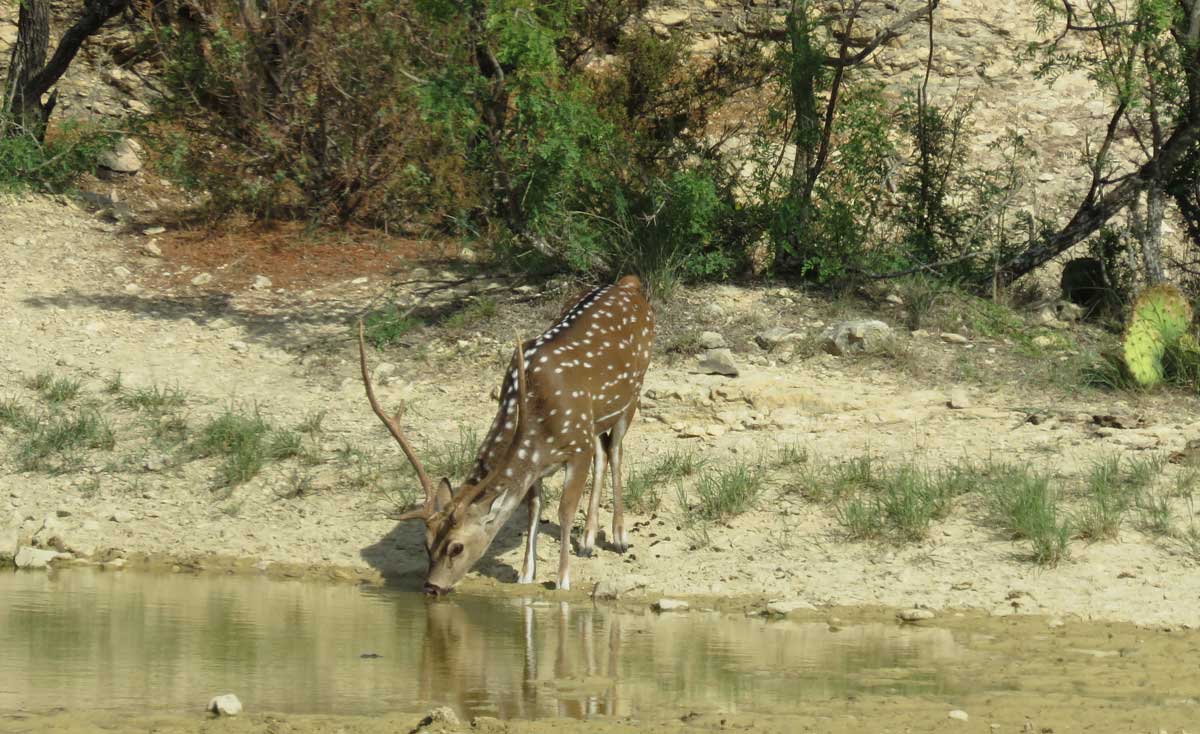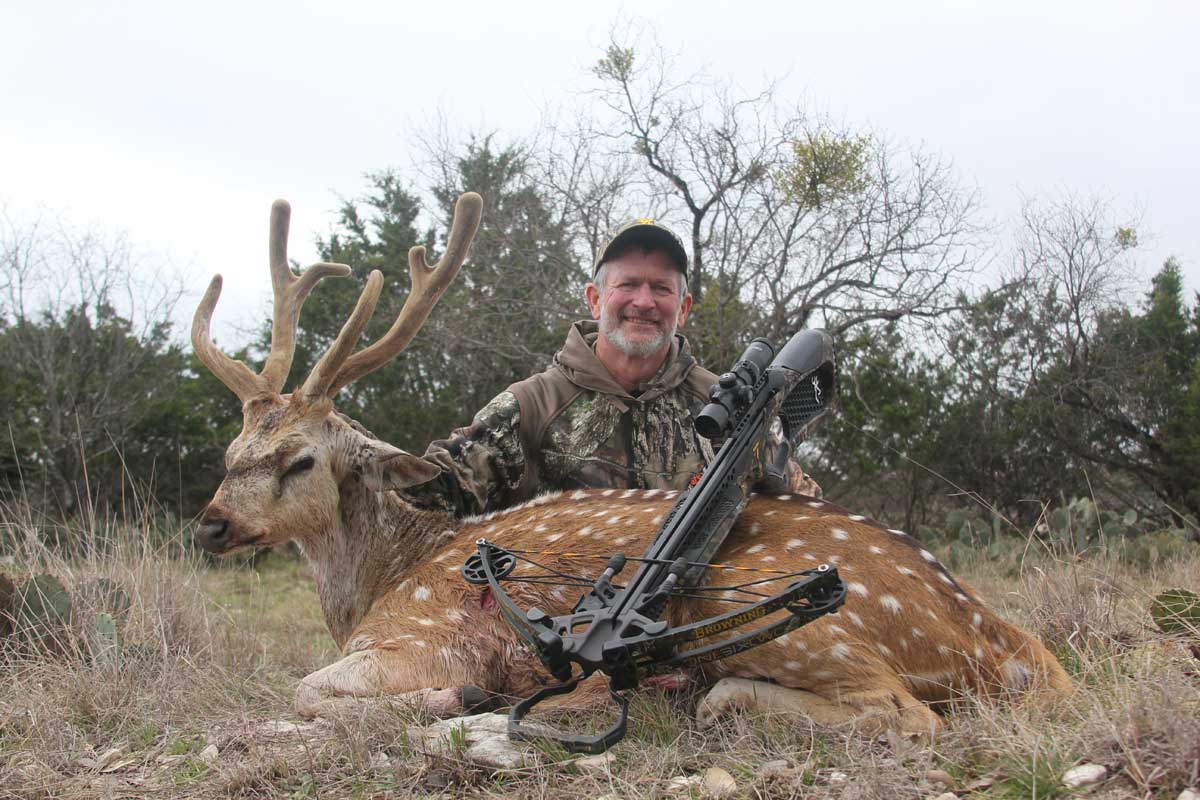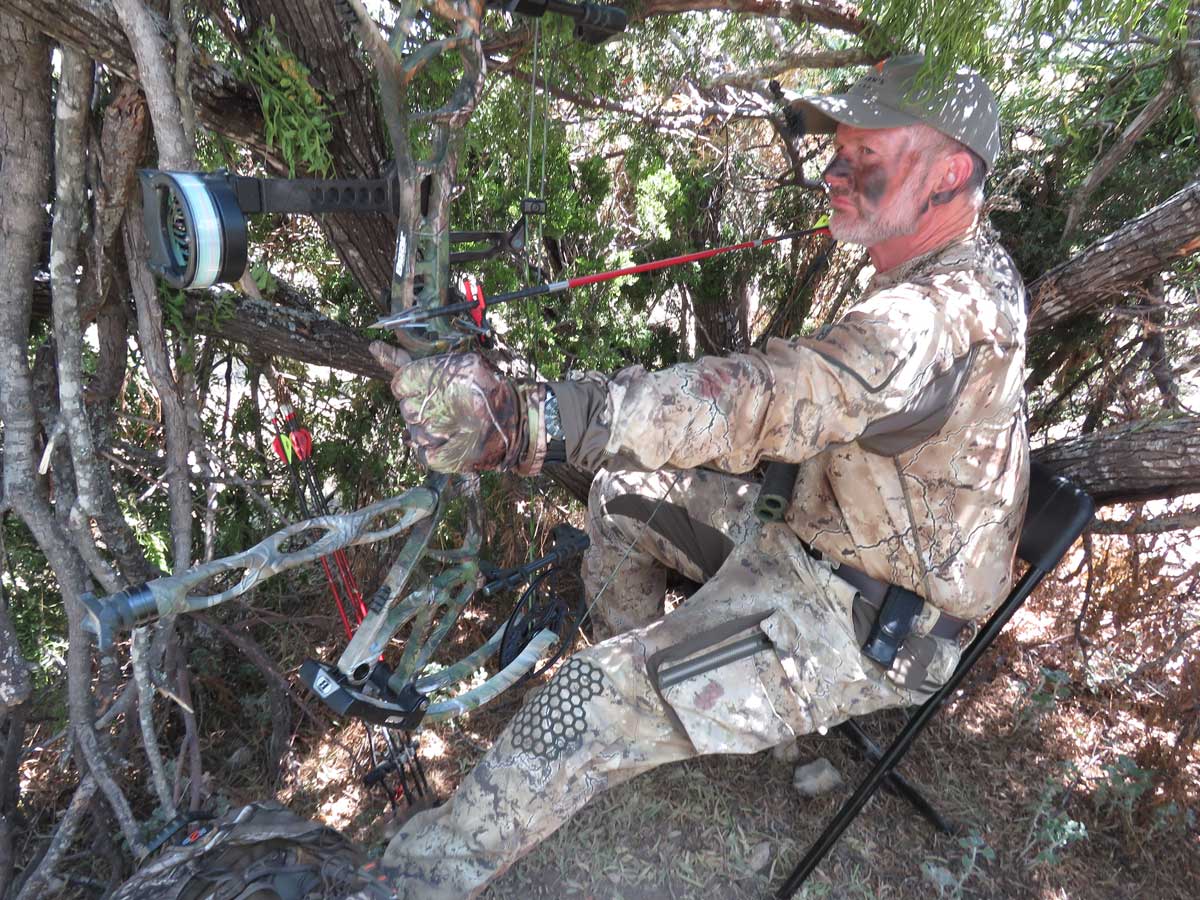Bowhunting Axis In South Texas
It was unseasonably warm for mid-February, even for South Texas, as I settled into my ground blind to see what might turn up that afternoon. The first three blind shifts had been unproductive only in that I had yet to have an opportunity at something I was hoping for — a nice axis deer buck and, later, a fat doe.
 Axis meat is without question some of the finest wild table fare on the continent, and after something of a lean fall, my freezer was a little low and Cheryl was starting to grumble. You know the drill, the one where your spouse gives you that look that says, “I thought you were a decent hunter and could keep us in meat, but maybe I need to head for Costco and stock up.”
Axis meat is without question some of the finest wild table fare on the continent, and after something of a lean fall, my freezer was a little low and Cheryl was starting to grumble. You know the drill, the one where your spouse gives you that look that says, “I thought you were a decent hunter and could keep us in meat, but maybe I need to head for Costco and stock up.”
I was at the plush JL Bar Ranch & Resort as part of an industry thing to test some new crossbows and accessories. Few places are more conducive to this type of work as a South Texas ranch loaded with exotic animals. Many SCI members have made such hunts, with good reason. Exotics in Texas can pretty much be hunted year-round, making it a great off-season gig, and on the JL we could take either an axis deer or fallow deer buck, plus a doe.
The game plan was pretty basic — up long before dawn, eat breakfast and be in the blind 30 minutes before first light. Hunt all morning, come back for lunch and some work, back out in the evening, hunt until dark, then feast on some of the JL’s incredible food. Rough, huh?
So on evening two, an hour before what we would have considered “prime time,” two axis bucks showed up. We had moved locations, and it paid off. I had my choice. One buck was youngish, but fat and prime. The other? Well, he was a lot like me, older, gray in the face, with a sway back and knobby knees, moving a little slower than he used to.
The decision was easy. Take the older guy. He needed to be removed from the herd, and besides, I felt a bit of kinship with this old greybeard. I rested the crossbow on my shooting sticks, settled the 30-yard mark of the scope’s reticle on the sweet spot and squeezed the trigger. The hybrid Gravedigger broadhead cut a massive hole, and the buck was down and out within 75 yards. The next morning I was in a new blind, and an hour after you could see, we were covered up in animals. There were eight axis deer, including one really good buck and four whitetail does. I chose a fat mature axis doe, and once again the crossbow sent a laser beam on its way. Just like that, I had enough superb meat to make Cheryl happy.
I had hunted axis deer in Texas before, but this was my first archery hunt for them. Since then I’ve bowhunted them four other times (and twice with rifles), and have really become a big fan. It’s a great way for hunters to spend quality time afield under conditions ideal for using archery equipment, be it compound bow, traditional archery gear or a crossbow. On the best ranches there is a lot of game, shots are taken under controlled conditions, and chances for success run very high. Often you can do a hunt over a long weekend, saving precious vacation days.
Axis Deer

Many SCI members have hunted axis deer, or chital (Axis axis), in their native lands on the Indian subcontinent, as well as the Hawaiian Islands and Texas. If you’ve never seen one before, they’re breathtakingly beautiful, sporting a bright reddish coat marked with rows of white spots that persist throughout life. Antlers of males are large but simple, usually with only three points. Adult males weigh up to 200 pounds, on average, and large females weigh in at about 130 pounds max, with most weighing somewhere near 100 lbs.
The axis deer was first introduced into Texas in the 1930s, and now occurs in at least 45 counties. The Texas Parks and Wildlife Department guesstimates that today there are between 6,000 and 8,000 free-ranging animals and 40,000 or more kept on high-fenced private hunting ranches in the Lonestar State. Essential habitat components include water, woody vegetation for cover and open areas for feeding. This deer is primarily a grazer, but its food habits are very general, and it can exist quite easily on forbs and woody browse.
The reproductive activity of the axis occurs year-round, but most breeding occurs in June and July. This means you are likely to experience at least some rutting activity, including hearing bucks roar, 12 months a year. It is not uncommon to see herds of bucks that feature animals of all ages and antlers size, including bucks with both hard antlers and antlers in velvet, as well as herds with both sexes of disparate ages. Single fawns are born the following spring after a 7 1/2-month gestation period. During the breeding period, males bellow loudly and wander in search of receptive females. Females mature sexually and first breed at 14 to 17 months of age. Males are capable of breeding as yearlings but must achieve adult size to compete for females.
Axis deer are more active by day than by night, with greatest activity occurring for two to three hours after dawn and again before dark. The size of the home range varies with habitat and averages 2 1/2 square miles in the coastal live oak region. Axis deer do not seem to be territorial, but males fight, often with serious consequences, for possession of females.
With few exceptions, in Texas axis deer are not regulated by game laws. While there is some axis deer hunting on public land, the vast majority occurs on private ranches where they are considered landowners’ property and may be bought, sold or hunted at any time. Therefore, they are important in sport hunting and offer hunting opportunities at times when native species are not available. Ranchers stock them for this purpose, and this practice explains their wide distribution in the state. Hunting occurs on both low-fence and high-fence properties.
A big bonus — the meat is lean, mild and devoid of any type of “sagebrush” taste. It’s some of the best I’ve ever eaten. In fact, axis deer meat contains less than one percent fat, is a beautiful deep red color, and is without question the tastiest game meat I have ever eaten. You can buy it in select meat stores and on the open market, ground axis meat can sell for upwards of $20/lb.
Gearing Up
One thing I have learned about axis bucks is that they are tough and possess a strong will to live. That means precise arrow placement is über critical.
I’ve found that the same archery equipment I use to hunt deer-sized game the world over is quite adequate for axis deer. That means a compound bow with a draw weight set somewhere between 60 to 70 lbs. and either carbon or aluminum shafts. All broadhead styles, including mechanical, replaceable-blade and fixed-blade designs work well, as long as the blades are razor sharp. Bow sights should have fiber-optic pins easily seen in dim light, and you should be prepared to shoot anywhere from point blank to 50 yards or so. A laser rangefinder is a must-have item.

If bowhunting includes sitting in a blind of some kind, bring along dark long-sleeved tops and hats and something to darken your face and hands. Also, be aware that axis deer are extremely skittish, so if you’re going to be sitting in a blind make sure you are able to draw your bow smoothly and easily without excess movement or making noise while sitting in a chair. Spot-and-stalkers are well-served with camouflage that mimics the Texas brush country. You might also ask the outfitter about rattlesnakes and the need for knee-high boots. Be prepared to combat ticks, chiggers and other biting insects.
Finding an Outfitter
Many SCI member outfitters offer axis deer hunting along with hunts for a variety of other exotic game as well as whitetails and wild hogs. The annual convention is a great place to chat them up. You can also find them advertising in the pages of this magazines and Safari Times. In addition to the JL Bar, one outfitter I’ve personally hunted with several times is SOE Hunts who has leases on two fabulous ranches loaded with axis deer. They understand how to make it work for bowhunters, which is critical. This is important when booking. I did a hunt in June 2018 with another outfitter near San Antonio who told my group they could handle archers, but when we arrived it was quickly apparent that was not the case. All of our hunters had to switch to rifles to have a chance, and then only half connected.
Another thing I like about axis deer hunting is the time factor. Most outfitted private ranch axis deer hunts generally last only three days, which eats up less than a week of your time when you factor in a day of travel to Texas on each end. And then there are the success rates. The reason axis hunts are usually only three days is that it’s the rare axis deer hunter who does not get a quality shot at a mature buck during this time. In fact, on many — though certainly not all — ranches you are allowed to take one axis buck, one axis doe and as many wild hogs as you can shoot during your hunt.
For example, on another hunt with SOE Hunts this summer I killed a dandy buck, a fat doe and four little piggies. In our camp of 12 total hunters — eight were bowhunters — everyone got a quality shot at a mature buck, and many other does and hogs were taken as well. Compare that to hunting Midwestern whitetails where the best guided hunts often have a one-in-three shot opportunity rate at a mature buck — or less — and no other animals can be harvested.
While costs vary, a fully-outfitted private-land axis hunt costs somewhere between $2,500 and $3,500 — less than most premium Midwestern whitetail deer hunts. On private ranches, if you want to buy more animals, you can do that, too. And the only hunting license a nonresident needs is the Nonresident Special 5-Day Hunting, Type 157, which costs $48.
How can you not want to give it a go?–Bob Robb

